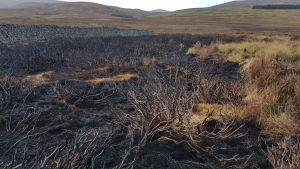Goss Moor NNR (Mid Cornwall Moors LIFE Project)
Introduction
Goss Moor NNR is the largest survivng remnant of the Mid-Cornwall moors. Its rich history spans from the legendary hunting grounds of King Arthur, to a record in the 1086 Domesday Book as part of the manor of Tremodret.
Between the 11th and 19th centuries the site was mined for tin, and later sand and gravel from the 1930s to the 1950s.
A visitor cycle trail has been put in place, so that people can better experience the site.
Description
Goss Moor NNR is situated in a relatively flat valley basin, which forms the headwaters of the River Fal. It contains areas of dry and wet heath, mire, fen and open water, and a diverse mix of wildlife habitats.
Restoration Delivered
- Scrub clearance - in particular willow and gorse; much is physically cut and removed, but controlled burning is also sometimes used if conditions are right in late winter
- Cattle grazing to prevent scrub from returning to cleared areas.
Biodiversity
Some of Cornwall's rarest vascular plants can be found on the site, such as the nationally scarce yellow centaury, marsh clubmoss, cornish moneywort and pillwort.
29 butterfly species have been recorded, including marsh fritillary. There are also 18 species of dragonflies and damselflies, including the nationally scarce small red damselfly and the variable damselfly. Dormice reside in the grassy open areas and in the areas dominated by willow. Otters are nocturnal visitors, as are roe deer.
Project Name: Goss Moor NNR (Mid Cornwall Moors LIFE Project)
Organisation / Lead partner: Natural England
Location: Saint Austell, Cornwall
Approximate area covered: 702 ha
Conservation Status: Site of Special Scientific Interest (SSSI), Special Area of Conservation (SAC), National Nature Reserves(NNR)
Predominately: Lowland
Peat Habitats: Lowland heath










